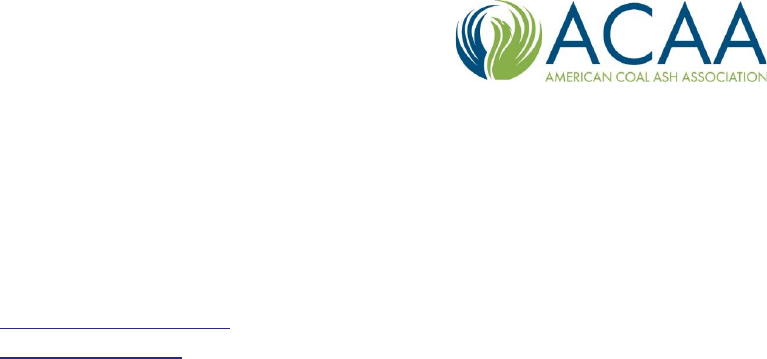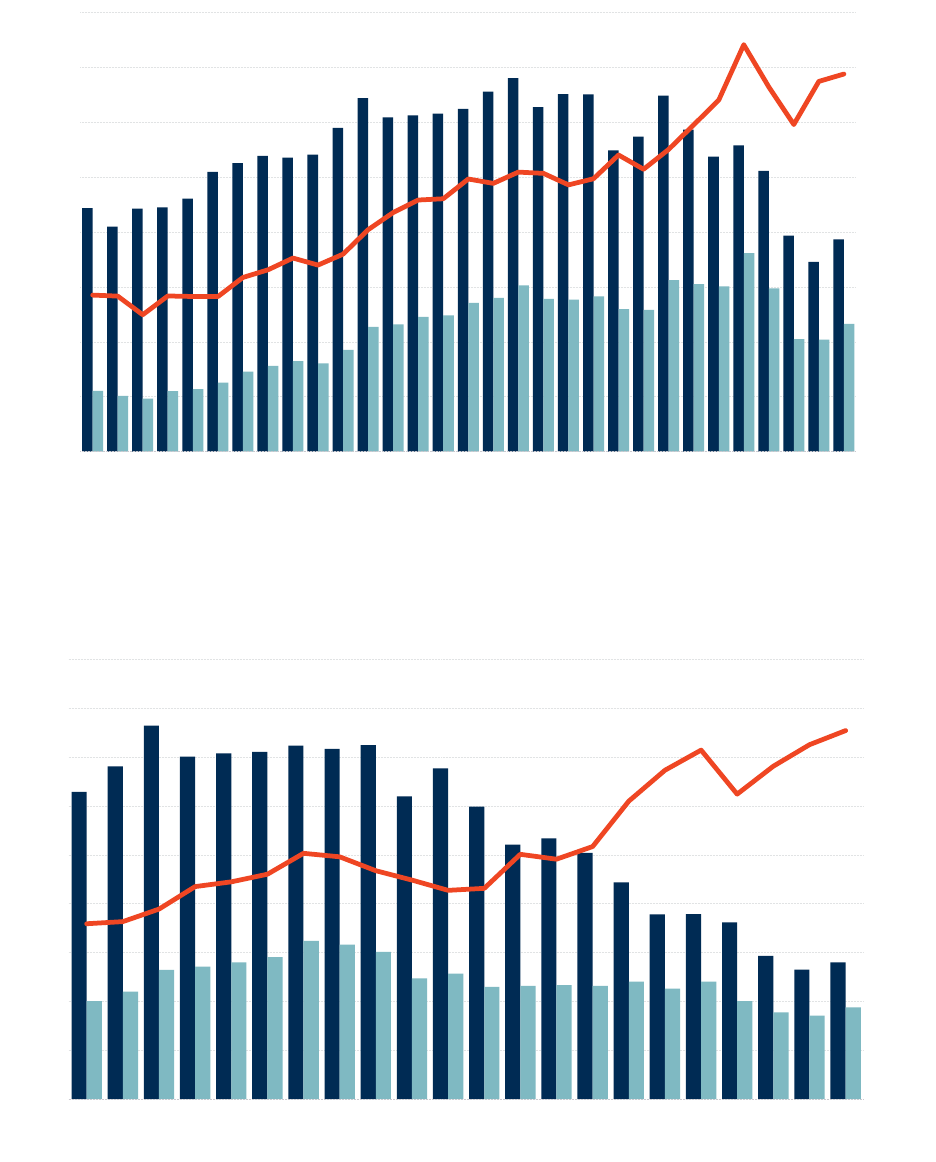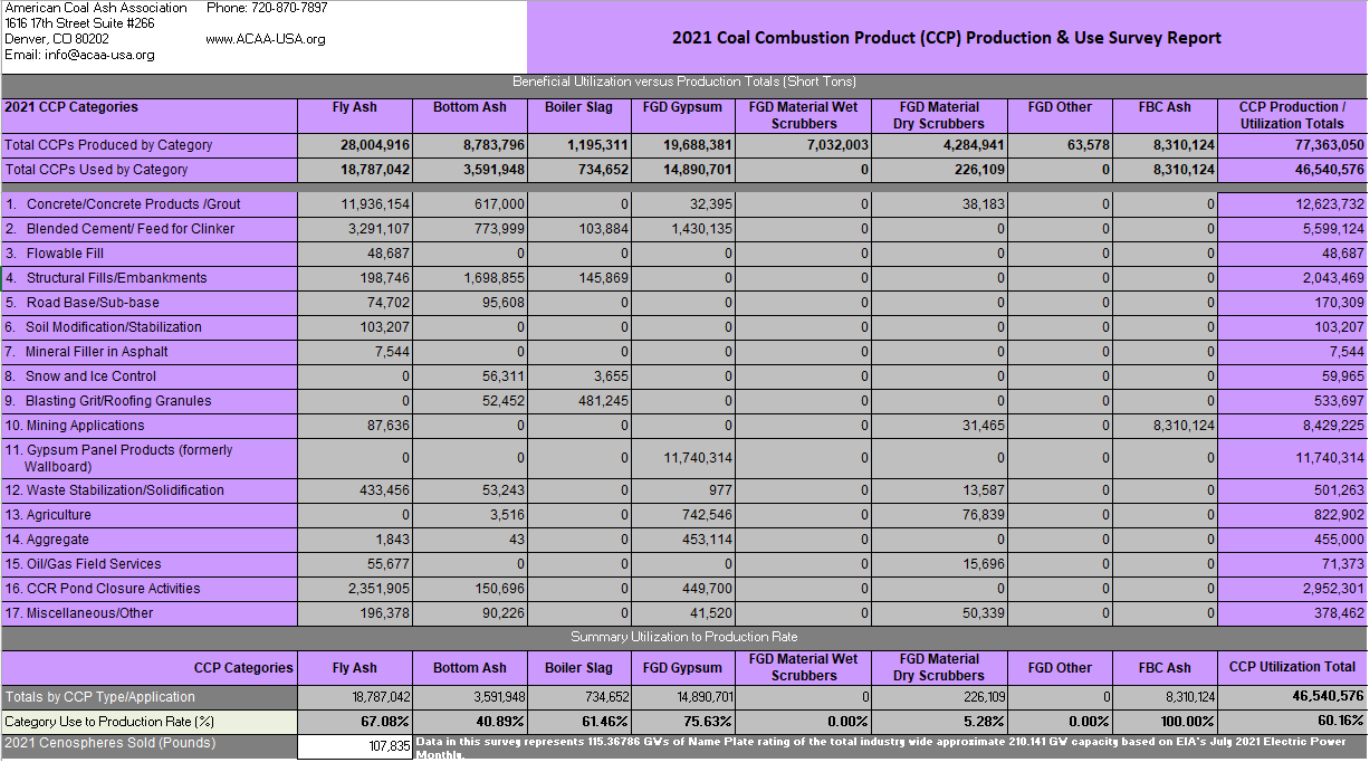
For Immediate Release
Contact: American Coal Ash Association
Thomas H. Adams, Executive Director
Office: 720-870-7897 Mobile: 720-375-2998
thadams@acaa-usa.org
www.acaa-usa.org
Coal Ash Recycling Rate Increases Slightly in 2021;
Use of Harvested Ash Grows Significantly
December 6, 2022 – Sixty percent of the coal ash produced during 2021 was recycled –
increasing from 59 percent in 2020 and marking the seventh consecutive year that more than
half of the coal ash produced in the United States was beneficially used rather than disposed.
American Coal Ash Association (“ACAA”) today released its annual “Production and Use Survey”
which also showed that use of harvested ash is continuing to grow. Nearly 4.5 million tons of
previously disposed ash was utilized in a variety of applications in 2021, including coal ash pond
closure activities, concrete products, cement kiln raw feed, and gypsum panel manufacturing.
The volume of harvested ash that was utilized increased 12 percent, or more than 500,000
tons, over the previous year.
“Harvested ash utilization volumes now equal nearly 10 percent of the volume of ash recycled
from current power plant operations,” said Thomas H. Adams, ACAA Executive Director. “The
rapidly increasing utilization of harvested coal combustion products (“CCP”) shows that
beneficial use markets are adapting to the decline in coal-fueled electricity generation in the
United States. New logistics and technology strategies are being deployed to ensure these
valuable resources remain available for safe and productive use. We must continue to support
these practices that safely conserve natural resources while dramatically reducing the need for
landfills.”
According to ACAA’s 2021 survey, 46.5 million tons of coal combustion products were
beneficially used in 2021, an increase of nearly 6 million tons over the previous year. Production
of new CCP also increased from 69.1 million tons in 2020 to 77.3 million tons in 2021 as utilities
consumed more coal for generating electricity.
Page 2 of 5
Page 2 of 5
“Coal ash” is a generic term that encompasses several coal combustion products that can be
beneficially used in a wide variety of applications. Highlights of CCP production and use in 2021
include:
• Use of coal fly ash in concrete increased slightly from 11.1 million tons to 11.9 million
tons. Concrete producers and consumers indicated a desire to use more fly ash, but
several regional markets continued to be affected by shifting supply dynamics
associated with closures of coal-fueled power plants. Fly ash improves concrete
durability and significantly reduces greenhouse gas emissions associated with concrete
production.
• Use of all coal combustion products in cement production increased 14 percent to 5.6
million tons.
• Utilization of a key “non-ash” coal combustion product also posted a significant
increase. Synthetic gypsum is a byproduct of flue gas desulphurization units, also known
as “scrubbers,” located at coal-fueled power plants. Use of synthetic gypsum in panel
products (i.e. wallboard) increased 15 percent to 11.7 million tons.
• Synthetic gypsum use in agricultural applications – in which the gypsum improves soil
conditions and prevents harmful runoff of fertilizers – remained about level at 822,902
tons.
• Use of CCP in pond closure activities declined from 3.4 million tons to just under 3
million tons. This activity is driven by utility compliance with coal ash regulations
enacted in 2015 that effectively require an end to the practice of wet disposal. Fly ash,
bottom ash, and synthetic gypsum were all used in construction of new permanent
disposal facilities.
• Use of CCP in structural fills rebounded in 2021 following several years of declines,
increasing from 816,543 tons in 2020 to just over 2 million tons in 2021.
• Production of boiler slag also rebounded from 834,000 tons in 2020 to 1.2 million tons
in 2021, with utilization in the production of blasting grit and roofing granules
increasing from 273,548 tons to 481,245 tons.
• Following a year in which no cenospheres were reported as being marketed, 2021 saw
107,835 pounds of the material sold.
Page 3 of 5
Page 3 of 5
“As America’s electricity grid changes, the coal ash beneficial use industry is evolving as well,”
said Adams. “As we work diligently to utilize the nearly half of coal combustion products that
are still disposed annually, our industry is also taking significant strides in developing strategies
for improving the quality and availability of these materials.”
Adams explained that increasing beneficial use requires ash marketers to ensure that products
are consistent and available when customers need them – requiring large investments in
technology and logistics. Additionally, the coal ash beneficial use industry is actively deploying
technologies and strategies for harvesting coal ash materials that were previously disposed.
About Coal Ash Recycling
Coal is the fuel source for approximately one-quarter of electricity generation in America and
produces large volumes of solid coal combustion products — primarily ash and synthetic
gypsum from emissions control devices.
There are many good reasons to view coal combustion products as a resource, rather than a
waste. Recycling them conserves natural resources and saves energy. In many cases, products
made with CCP perform better than products made without it. For instance, coal fly ash makes
concrete stronger and more durable. It also reduces the need to manufacture cement, resulting
in significant reductions in greenhouse gas emissions – about 12 million tons in 2021 alone.
Major uses of coal combustion products include concrete, gypsum wallboard, blasting grit,
roofing granules, and a variety of geotechnical and agricultural applications.
About ACAA’s Production and Use Survey
American Coal Ash Association – an organization that advances the environmentally responsible
and technically sound use of coal ash as an alternative to disposal – has conducted a survey
quantifying the production and use of coal combustion products in the United States each year
since 1966. Data is compiled by directly surveying electric utilities and utilizing additional data
produced by the U.S. Energy Information Administration. The survey’s results have been widely
utilized by federal agencies including the U.S. Environmental Protection Agency and U.S.
Geological Survey.
Charts summarizing overall production and use data since 1991 and fly ash production and use
since 2000 are included below. A complete copy of the 2021 survey results is on the final page.

Page 4 of 5
Page 4 of 5
All CCPs Production and Use with Percent Used
Fly Ash – Production and Use
Produced
Used
Percent Used
(Right Axis)
0%
10%
20%
30%
40%
50%
60%
70%
0
20
40
60
80
100
120
140
160
1991
1992
1993
1994
1995
1996
1997
1998
1999
2000
2001
2002
2003
2004
2005
2006
2007
2008
2009
2010
2011
2012
2013
2014
2015
2016
2017
2018
2019
2020
2021
Percent Used
All CCPs
(Millions of Short Tons)
Produced
Used
Percent Used
(Right Axis)
0%
10%
20%
30%
40%
50%
60%
70%
80%
0
10
20
30
40
50
60
70
80
90
2000
2001
2002
2003
2004
2005
2006
2007
2008
2009
2010
2011
2012
2013
2014
2015
2016
2017
2018
2019
2020
2021
Percent Used
Fly Ash (Millions of Short Tons)

